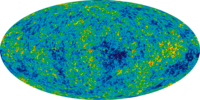
Photo from wikipedia
This letter analyzes the background signals and thermal noise received over ocean scenes in spaceborne global navigation satellite system (GNSS)-reflectometry (GNSS-R) remote sensing using observations from the cyclone GNSS (CYGNSS)… Click to show full abstract
This letter analyzes the background signals and thermal noise received over ocean scenes in spaceborne global navigation satellite system (GNSS)-reflectometry (GNSS-R) remote sensing using observations from the cyclone GNSS (CYGNSS) constellation. The measured noise floor contains a stable and predictable radiometric thermal noise component and a more variable background signal component from unintended specular reflections within the CYGNSS receive antenna pattern from all GNSS satellite constellations (GPS, Galileo, GLONASS, Beidou, and all SBAS). The presence of SBAS reflections, in particular, is evident in the noise floor measurements, especially the U.S. wide area augmentation system (WAAS) satellites. The results show that the impact is negligible, since background signal contributions by other GNSS transmitters affect both the “signal” and “noise” portions of CYGNSS’s delay Doppler map measurements, and therefore cancel when the measured noise floor is subtracted from the desired signal. The potential increase in measurement uncertainty introduced by any residual background signal to the CYGNSS calibration is analyzed.
Journal Title: IEEE Geoscience and Remote Sensing Letters
Year Published: 2020
Link to full text (if available)
Share on Social Media: Sign Up to like & get
recommendations!